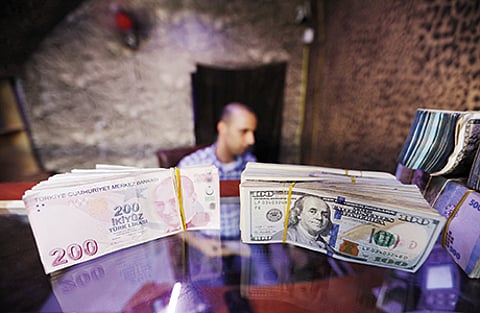Spectre of contagion keeps many emerging markets investors on the edge
Severity of recent market moves has increased anxiety of a wider sell-off

Dubai: The exchange rate vulnerability of emerging markets often comprises many factors ranging from domestic economic conditions, direction of portfolio investment flows and a large number of external factors such as trade barriers and relative strength of the US dollar.
According to the Institute of International Finance (IIF), in the run-up to this sell-off, for example, Argentina’s peso and the Turkish lira had markedly different trajectories, with the peso unwinding a previous appreciation, while the lira continues a trend depreciation that has been ongoing for many years.
“At this stage in the EM sell-off, the lira and the peso have depreciated more than needed to offset macro imbalances and are undervalued. Indeed, in other cases where currencies were overvalued — India and South Africa — nominal depreciation has shrunk the misalignment to essentially zero,” the IIF said in a recent note
Analysts see the severity of recent market moves has increased anxiety over possible contagion and here are a few markets to look out for.
■ Turkey
The sharp devaluation of the Turkish lira following a series of unconventional macroeconomic policies and monetary policy decisions has seen the currency plunging more than 40 per cent year to date and sending the shock waves through global financial makers spreading a spectre of a contagion across emerging markets. Heightened political tensions between the US and Turkey has clearly weighed on investor appetitive for emerging market assets, putting further pressure on a broad range of EM assets and currencies.
Contagion and spillovers have also been evident in cross-border portfolio flows. Economists and market analysts fear that the reverberations of the Turkish crisis felt across many emerging markets will have longer than expected consequences on their currencies, asset classes and investment flows.
■ Argentina
Argentina, reeling from its worst currency crisis in 17 years, has seen the peso falling more than 60 per cent this year to become the worst among the emerging market currencies. In a desperate bid to support the currency and the economy, the country recently appealed the developed world to ditch the rule book and buy the sovereign debt of emerging markets as part of their reserves. Luis Caputo, the central bank president, called on central banks to invest as much as two per cent of their reserves in countries with loan packages from the International Monetary Fund (IMF).
Argentina is in talks to speed up disbursement of money from a record $50 billion (Dh183.63 billion) credit line with the IMF. The pesos’ decline worsened amid concern about the government’s ability to finance itself during the second recession in three years. The central bank raised the key interest rate to 60 per cent last week to curb rampant inflation.
■ India
Indian rupee has been on a free fall since the beginning of this year, declining 12 per cent to become the worst performing Asian currency. While macroeconomic fundamentals of the country can’t be blamed to a great extent for the woes of the rupee, it is a fact that a confluence of external factors have hammered the currency.
For India, excessive dependence on oil imports is its Achilles heel in forex management. Crude prices have risen from $65 to $80, ever since US President Donald Trump decided to cancel the Iran nuclear deal. India imports 70 per cent of its crude requirements and any rally in crude, inflates the import bill and impacts the currency as well.
■ Indonesia
Indonesia is the largest economy in South-east Asia and has approximately forty per cent of its debt denominated in foreign currencies. Last week the rupiah, Indonesia’s currency, fell to its weakest level since the 1998 Asian financial crisis, having lost 10.5 per cent against the dollar since the start of this year. Indonesia’s central bank has hiked interest rates four times since May and intervened heavily in a bid to shore up the rupiah.
■ Brazil
Brazil, headed for its presidential election next month, is facing a huge currency crisis as the real plunged close to 30 per cent this year as the Latin American economy continues to reel from its worst-ever recession.
■ South Africa
The rand, down 24 per cent a year to date, fell sharply last week as newly released data showed that South Africa’s economy fell into recession last quarter for the first time since 2009.
■ Russia
The Russian rouble continues to decline, as the dollar continued to gain substantial ground against the emerging market basket of currencies. Geopolitical pressure related to the resumption of discussion of the bill on new US sanctions against Russia may give bearish sentiment for the currency this week, together with possible oil price correction. The rouble’s year-to-date loss against the greenback is more than 17 per cent.
Sign up for the Daily Briefing
Get the latest news and updates straight to your inbox



